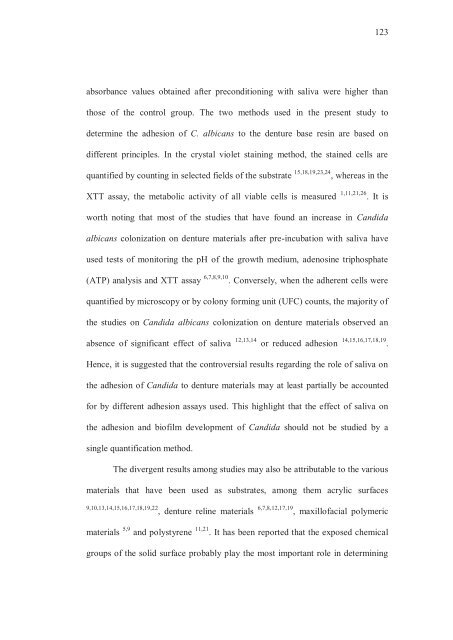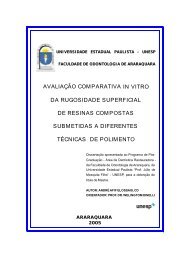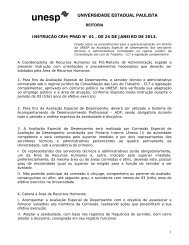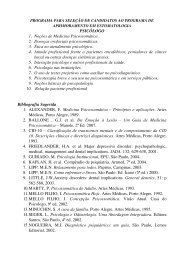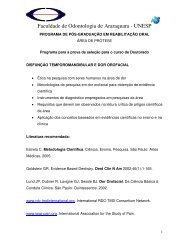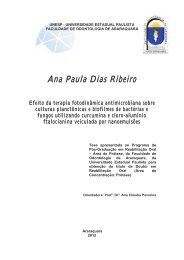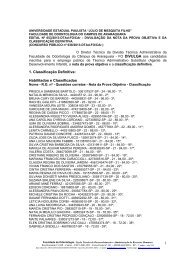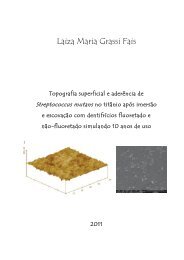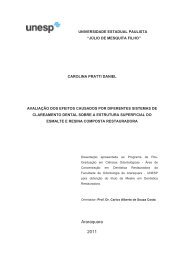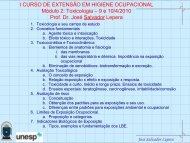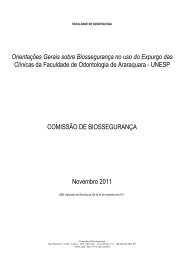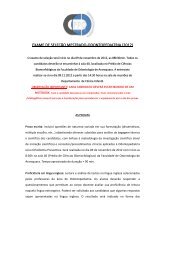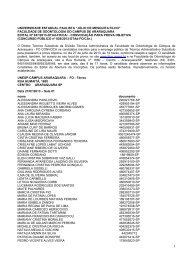universidade de são paulo - Faculdade de Odontologia - Unesp
universidade de são paulo - Faculdade de Odontologia - Unesp
universidade de são paulo - Faculdade de Odontologia - Unesp
Create successful ePaper yourself
Turn your PDF publications into a flip-book with our unique Google optimized e-Paper software.
123<br />
absorbance values obtained after preconditioning with saliva were higher than<br />
those of the control group. The two methods used in the present study to<br />
<strong>de</strong>termine the adhesion of C. albicans to the <strong>de</strong>nture base resin are based on<br />
different principles. In the crystal violet staining method, the stained cells are<br />
quantified by counting in selected fields of the substrate 15,18,19,23,24 , whereas in the<br />
XTT assay, the metabolic activity of all viable cells is measured 1,11,21,26 . It is<br />
worth noting that most of the studies that have found an increase in Candida<br />
albicans colonization on <strong>de</strong>nture materials after pre-incubation with saliva have<br />
used tests of monitoring the pH of the growth medium, a<strong>de</strong>nosine triphosphate<br />
(ATP) analysis and XTT assay 6,7,8,9,10 . Conversely, when the adherent cells were<br />
quantified by microscopy or by colony forming unit (UFC) counts, the majority of<br />
the studies on Candida albicans colonization on <strong>de</strong>nture materials observed an<br />
absence of significant effect of saliva 12,13,14 or reduced adhesion 14,15,16,17,18,19 .<br />
Hence, it is suggested that the controversial results regarding the role of saliva on<br />
the adhesion of Candida to <strong>de</strong>nture materials may at least partially be accounted<br />
for by different adhesion assays used. This highlight that the effect of saliva on<br />
the adhesion and biofilm <strong>de</strong>velopment of Candida should not be studied by a<br />
single quantification method.<br />
The divergent results among studies may also be attributable to the various<br />
materials that have been used as substrates, among them acrylic surfaces<br />
9,10,13,14,15,16,17,18,19,22 , <strong>de</strong>nture reline materials 6,7,8,12,17,19 , maxillofacial polymeric<br />
materials 5,9 and polystyrene 11,21 . It has been reported that the exposed chemical<br />
groups of the solid surface probably play the most important role in <strong>de</strong>termining


